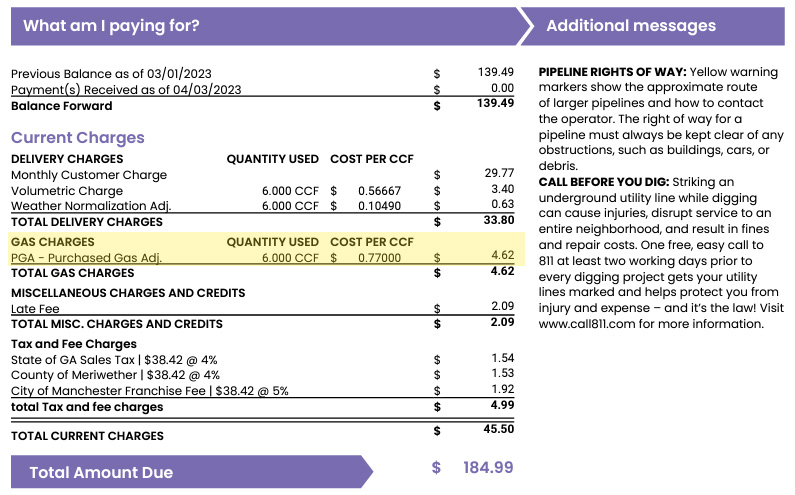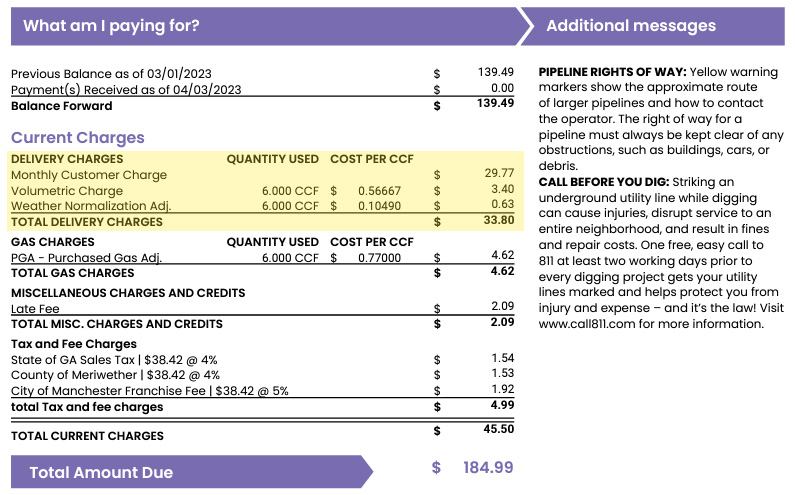Understanding Rates and Tariffs - Residential - Georgia Gas - Liberty
Understanding Rates & Tariffs
Liberty is a regulated utility; our rates must be reviewed and approved by state regulators. Rates reflect the cost to provide safe, reliable natural gas service, customer account services, emergency response, maintain and improve system infrastructure to comply with state and federal regulations. Rates also reflect the cost and obligation of serving our customers safely and reliably.
Each year, Liberty files a Gas Supply Plan with the Georgia Public Service Commission (PSC) to recover the cost of natural gas it delivers to customers. This cost is determined by the natural gas market and passed through to customers without markup. It can be affected by many factors including weather patterns, supply and demand, and access to locally sourced natural gas. On your bill, this charge is listed as the Purchased Gas Adjustment.
Liberty also annually files a review of volumetric charges (also referred to as delivery charges) through the Georgia Rate Adjustment Mechanism (GRAM). For this, a rate review filing is prepared and submitted to the Georgia Public Service Commission (PSC). A rate review provides a detailed description of the circumstances that support the need for a rate change; this may include infrastructure upgrades, investments in safety and security, and other operational needs. State regulators may approve or deny rate reviews or ask that they be modified. We work closely with state regulators to ensure our rates are fair and our service remains safe and reliable.
Once rates are approved, they become part of our larger tariff document. Tariffs are a detailed accounting of the services we deliver, our rates for those services and the policies to which we adhere.
When rates change, we communicate these changes to our customers through your monthly bills, advertisements in local newspapers, and on this website.
What to expect with 2024-2025 Rates
There are two primary categories of charges on your monthly bill – the cost of natural gas and the cost associated with delivering the natural gas to your home or business. In addition to these charges, customers will also see various city, county, and state taxes. For an in-depth explanation of your bill, click here.
Gas Supply Plan (Cost of Natural Gas)

In September 2024, Liberty filed a gas supply plan with the Georgia PSC (Purchased Gas Adjustment or PGA on your bill). This plan accounts for forecasted gas commodity costs as well as transportation costs. For the 12-month window from October 1, 2024 – September 30, 2025, the Purchased Gas Adjustment rates are expected to be about 4% higher than they were during the previous year. This is largely due to the expiration of prior year gas refunds related to the cost of natural gas and transportation.
GRAM Rates (Cost for Delivering the Natural Gas)

The Georgia Rate Adjustment Mechanism (GRAM) is referenced on your bill as “delivery charges” and includes costs such as maintenance, safety and inspection programs, and customer service metering and billing. On March 1 2025, new GRAM rates became effective in order to support numerous system improvements. These include:
- Transmission and distribution system improvements to continue safe and reliable systems operations
- Addition of renewable natural gas interconnections to reduce carbon emissions
- Continued investment in cyber security
- Enhancement of transmission and distribution system damage prevention initiatives
The overall impact of the rate increase is $2.33 per month for the typical residential customer, from March 1, 2025 – February 28, 2026. That’s about $27.94 per year.
Liberty works very hard to strike a balance between providing service that is safe, reliable and cost-effective for our customers. We also offer several financial assistance programs, budget billing, and other offerings to help our customers manage their monthly bills. Click here to learn more and find a program that fits your needs.
